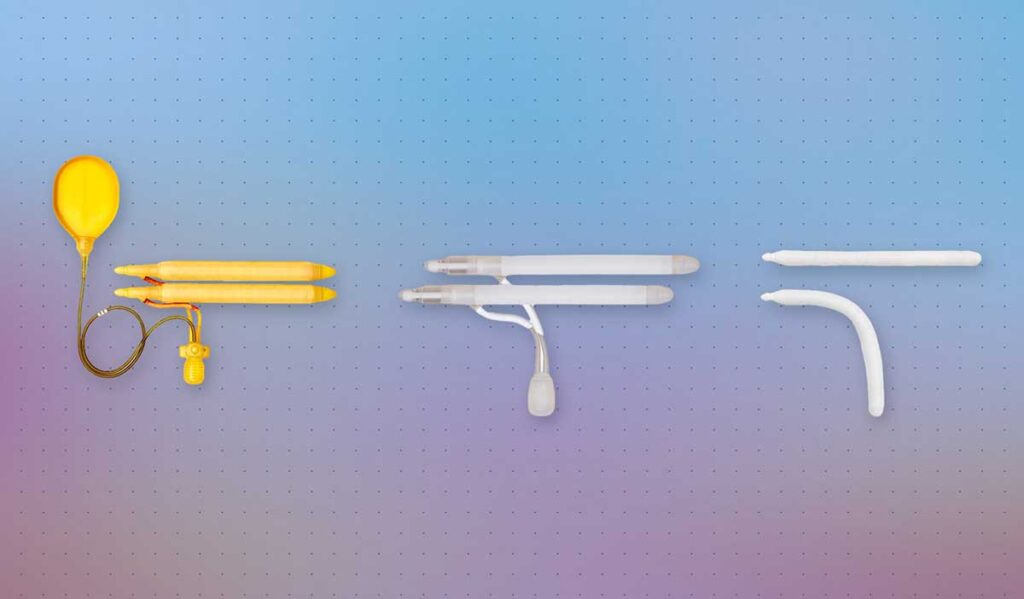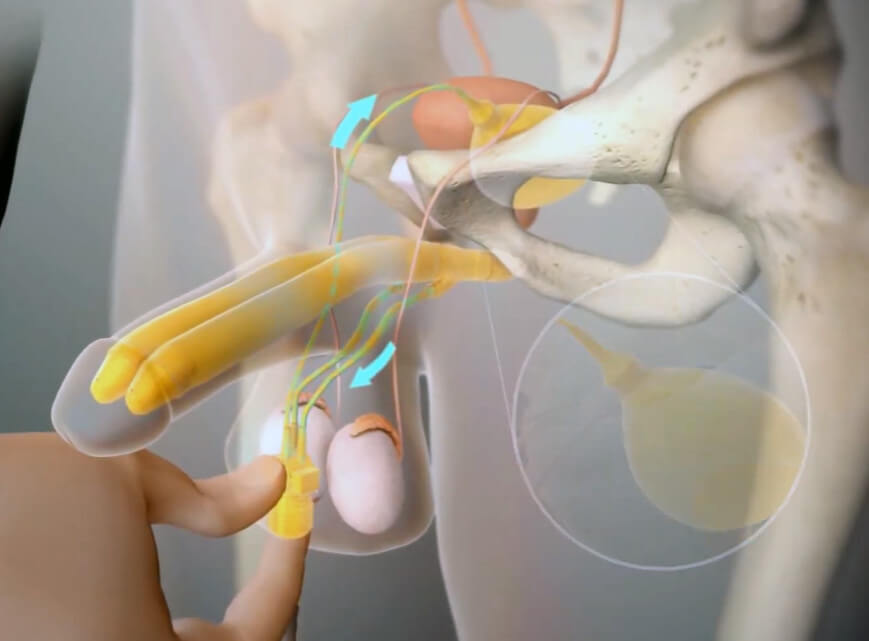Penile prosthesis surgery is an effective treatment method applied to men who are unable to achieve or maintain an erection during sexual intercourse, helping to facilitate their sexual life. Individuals with a penile prosthesis can maintain an erection in a controllable manner and sustain a healthy sexual life. This not only strengthens their relationship with their partner but also helps them regain their lost self-confidence. Penis implants, selected according to the patient's needs, are made of high-quality, reliable materials and are designed for lifelong use.
What is a Penile Prosthesis?
A penile prosthesis (penile implant) is a device that provides a permanent solution for men experiencing erectile dysfunction. Also known as an implant, this device is placed inside the penis to enable an erection whenever desired and for as long as needed. With a penile prosthesis:
- A healthy sexual life can be maintained.
- Relationships with partners can be strengthened.
- Lost self-confidence can be regained.
- Types of Penile Prostheses
Penile prostheses vary depending on the patient’s needs and preferences. The different types are listed below:
1. One-Piece Malleable Penile Prosthesis
- Structure: Composed of two bendable cylinders.
- Advantages: Easy to use; ideal for patients with Parkinson’s disease or hand mobility issues.
- Disadvantages: The penis remains in a semi-erect state at all times.
2. Two-Piece Inflatable Penile Prosthesis
- Structure: Consists of two cylinders and a pump
- Usage: Fluid is transferred to the cylinders via a pump to achieve an erection. The fluid can be withdrawn using the pump when an erection is no longer needed.
- Advantages: Provides a more natural appearance.
3. Three-Piece Inflatable Penile Prosthesis
Structure:
- Cylinders: Placed inside the penis.
- Pump: Positioned in the scrotum.
- Reservoir: Located in the abdominal area.
Advantages:
- Expansion in both length and girth.
- The most natural erection experience.
Comparison Table of Penile Prosthesis Types
| Feature | One-Piece | Two-Piece | Three-Piece |
|---|---|---|---|
| Erection Mechanism | Permanent Erection | Controlled Erection | Controlled Erection |
| Ease of Use | High | Medium | Low |
| Natural Appearance | Moderate | High | Very High |
| Mechanism Complexity | Simple | Moderate | Complex |

How is Penile Prosthesis Surgery Performed?
- Preoperative Preparation
- The patient's medical condition is evaluated.
- The appropriate type of prosthesis is determined.
Surgical Procedure
- General anesthesia is administered.
- The prosthesis is inserted through an incision made at the lower part of the penis.
- The incision is closed with aesthetic sutures.
- The procedure takes approximately 45-90 minutes.
Postoperative Care
- The patient stays in the hospital for one night.
- Sexual activity should be avoided for six weeks.
Who is a Candidate for Penile Prosthesis?
Penile prosthesis surgery is performed on individuals diagnosed with erectile dysfunction who are unable to achieve or maintain an erection. To be eligible for the procedure, the patient must not have any medical conditions that could prevent surgery and must have completed physical development. Penile prosthesis surgery is particularly recommended for cases where other treatment methods have failed, offering an effective and permanent solution.
What Causes Erectile Dysfunction?
Erectile dysfunction is the inability to achieve or maintain sufficient rigidity for sexual intercourse. This condition may result from factors such as aging, psychological disorders, or side effects of certain medications. Additionally, some medical conditions can gradually lead to erectile dysfunction. Below are the primary causes of erectile dysfunction that can be treated with a penile prosthesis:
Factors Leading to Erectile Dysfunction
| Factor | Description |
|---|---|
| Diabetes | Can affect blood circulation and nerve function, leading to erectile dysfunction. |
| Prostate Cancer | Erectile dysfunction may occur after prostate surgery or radiation therapy. |
| Penile Curvature | Conditions such as Peyronie’s disease can cause pain and erectile dysfunction during erection. |
| Spinal Cord Diseases | Spinal cord injuries or diseases can disrupt nerve signal transmission, leading to erectile dysfunction. |
| Cardiovascular Diseases | These conditions affect blood flow and may prevent sufficient blood supply to the penis. |
| Rectal Cancer | Damage to pelvic nerves during treatment can result in erectile dysfunction. |
| Radiation Therapy to the Pelvic Region | Radiation therapy can cause permanent damage to nerves and blood vessels. |
Before & After Penile Prosthesis Surgery
Penile prosthesis surgery is an effective treatment option for individuals experiencing erectile dysfunction. This procedure can help improve the patient's quality of life; however, a proper recovery process is essential for success. The pre- and post-surgery phases may vary depending on the patient’s health, recovery speed, and adherence to treatment.
Before Surgery: Preparation
Before the surgery, patients go through a detailed evaluation process with their doctor. During this process, the following factors are considered:
- Health Assessment: The overall health condition is checked, and existing health issues (such as heart disease) are taken into account.
- Review of Treatment Methods: The outcomes of other treatment methods (such as medications, vacuum pumps, etc.) are evaluated.
- Psychological Preparation: Considering the psychological effects of erectile dysfunction, some patients may prefer to receive psychological support before surgery.
- Prosthesis Selection: Based on the patient's needs, options such as inflatable or malleable prostheses are assessed.
After Surgery: Recovery Process
The recovery process after penile prosthesis surgery is generally comfortable. However, patients should follow important guidelines for a smooth recovery.
First Week:
- Swelling and Redness: Mild swelling and redness around the surgical site are normal and usually subside within 7-10 days.
- Pain Management: Mild pain may occur, which can be managed with prescribed pain relievers.
- Antibiotic Use: To prevent infection, antibiotics may be necessary and should be taken as directed.
- Rest: Daily activities should be limited, and patients should focus on getting enough rest.
Weeks 1-4:
- Restriction on Physical Activities: Strenuous exercise, heavy lifting, and sports activities should be avoided.
- Hygiene: Proper care of the surgical area is crucial to prevent infections and reduce swelling.
- Avoid Hot Baths and Steam Rooms: Exposure to high temperatures, such as hot baths and saunas, can negatively affect the healing process.
After 6 Weeks:
- Resumption of Sexual Activity and Sports: Sexual intercourse and light physical activities can generally be resumed after six weeks with the doctor’s approval.
- Adjustment to the Prosthesis: The use of the prosthesis becomes more comfortable, though individual adaptation may vary. Patients may need some time to get used to their prosthesis.
Complete Recovery Period (6-8 Weeks):
- Reduction of Swelling and Sensitivity: By the end of the recovery period, swelling subsides completely, and sensitivity in the area decreases.
- Ease of Prosthesis Use: Patients achieve full comfort in using the prosthesis without experiencing difficulties in daily life.
- Psychological Improvement: As the recovery progresses, patients may experience an improvement in their sexual life and an increase in self-confidence. Psychological support may be beneficial during this process.
Important Considerations During Recovery
- Regular Check-Ups: Post-surgery doctor visits should not be neglected, as they help detect any potential complications early.
- Prosthesis Maintenance: If any issues arise with the prosthesis, it is essential to consult a doctor immediately.
- Patience is Key: Full recovery takes time, and patients should remain patient throughout the healing process.
- Follow the Doctor’s Instructions: All post-surgery guidelines must be carefully followed for a successful outcome.
Penile Prosthesis Surgery Prices
The cost of penile prosthesis surgery varies depending on the following factors:
- Type of Prosthesis: One-piece, two-piece, or three-piece.
- Brand: AMS 700, Coloplast Titan, Rigicon, etc.
- Surgeon's Experience: The expertise of the specialist performing the surgery.
- Hospital and Material Quality: FDA-approved materials and their durability.
Comparison of Popular Penile Prosthesis Brands
| Brand | Model | Advantages |
|---|---|---|
| AMS 700 | LGX, CX | Most natural feel, expansion feature |
| Coloplast | Titan Touch | High durability, soft tissue compatibility |
| Rigicon | Infla10 | Affordable, long lifespan |
Benefits of Penile Prosthesis Surgery
Penile prosthesis surgery offers numerous advantages:
- Full Rigidity: The prosthesis ensures an erection for as long as desired.
- Natural Appearance: Three-piece prostheses provide the most natural feel.
- Improved Sexual Performance: Eliminates erectile dysfunction completely.
- Long Lifespan: High-quality materials allow for years of hassle-free use.
- Psychological Benefits: Patients regain self-confidence and experience positive effects in their social relationships.
Frequently Asked Questions (FAQ)
Is a Penile Prosthesis Permanent?
Penile prostheses are designed for long-term use, with high-quality materials lasting 15-20 years. If no mechanical issues occur, they can be used for a lifetime. The longevity of the prosthesis depends on selecting the most suitable type, which is why it is crucial to have the procedure performed by experienced urologists.
Does a Penile Prosthesis Provide Full Rigidity?
Three-piece penile prostheses are the most preferred models due to their high satisfaction rate. They offer excellent rigidity, significantly enhancing the patient's sexual experience.
Can Someone with a Penile Prosthesis Ejaculate?
A penile prosthesis (also known as a "happiness stick") is solely designed to treat erectile dysfunction. It does not affect ejaculation, orgasm, or overall sexual performance. Instead, it boosts confidence, allowing for a more comfortable sexual experience.
Is a Penile Prosthesis Noticeable from the Outside?
Penile prostheses are not externally visible.
One-piece prostheses: Can be manually bent and tucked inside underwear when not in use.
Two-piece or three-piece prostheses: Remain in a flaccid state when not activated and are undetectable.
How Long is a Penile Prosthesis?
Penile prostheses do not have a fixed length. The size is customized based on the patient’s physical characteristics, penis length, and the type of prosthesis chosen.
How Many Years Can a Penile Prosthesis Be Used?
FDA-approved penile prostheses are made from lifetime-guaranteed materials. Malfunctions are rare, and the prostheses used in our center meet the highest quality and safety standards.
How Does a Penile Prosthesis Deflate?
- One-piece prostheses: Can be manually bent and hidden.
- Two-piece or three-piece prostheses: The fluid inside the penis returns to the pump or reservoir with a simple press on the prosthetic pump. They are easy to use and can be controlled effortlessly by the patient.
Who is a Candidate for Penile Prosthesis Surgery?
Penile prosthesis surgery is suitable for individuals diagnosed with erectile dysfunction who have not benefited from other treatment methods and have no medical conditions preventing surgery.
What Are the Types of Penile Prostheses?
- One-Piece (Malleable) Prostheses: Simple and easy to use.
- Two-Piece Prostheses: Provide a more natural experience.
- Three-Piece Prostheses: The most advanced option, offering the highest level of satisfaction.
![dr.leyla-arvas-800×1000.jpg[1] dr.leyla arvas](https://www.quartz.com.tr/wp-content/uploads/2024/11/dr.leyla-arvas-800x1000.jpg1_.webp)
Author : Op. Dr Leyla ARVAS
Dr Leyla Arvas is an internationally recognised specialist in aesthetic surgery based in Istanbul. Graduated in 1998 from Istanbul University Faculty of Medicine, she has developed her expertise by studying in Taiwan, Japan and Spain during her 20 years of experience.
This article April 13, 2025 was updated on
Editor: admin@quartz.com.tr



